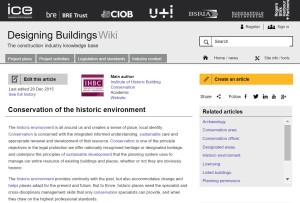 Following an invitation from Designing Buildings Wiki, the new online construction industry knowledge base hosted by CIOB, ICE, BRE Trust and others, the IHBC has contributed a foundation article on the ‘conservation of the historic environment’.
Following an invitation from Designing Buildings Wiki, the new online construction industry knowledge base hosted by CIOB, ICE, BRE Trust and others, the IHBC has contributed a foundation article on the ‘conservation of the historic environment’.
IHBC Director Seán O’Reilly said: ‘We’re delighted to have been invited to contribute to this innovative new resource for our sector.
‘It is of course a privilege to be offered the opportunity to work with and help shape more mainstream understanding of just what historic environment conservation entails. And maybe even dispose of a few of the more ill-informed tropes that still populate both popular and specialist publications.’
‘Of course as it’s wiki-based, our contribution is open to wider shaping and evolution, as with any decent specialist activity, while we look forward to contributing more detailed content to this important, and free-to-use, new resource’.
Designing Buildings Wiki writes:
Designing Buildings Wiki is the only industry-wide, cross-discipline forum for finding and sharing information. Anyone can create articles about subjects they know and anyone can find articles about subjects they don’t.
More than 4,200 people have become registered users.
As at December 30 the Designing Buildings Wiki entry reads (with hyperlinks removed):
Conservation of the historic environment
The historic environment is all around us and creates a sense of place, local identity. Conservation is concerned with the integrated informed understanding, sustainable care and appropriate renewal and development of that resource. Conservation is one of the principle objectives in the legal protection we offer nationally recognised heritage or designated heritage, and underpins the principles of sustainable development that the planning system uses to manage our entire resource of existing buildings and places, whether or not they are obviously historic.
The historic environment provides continuity with the past, but also accommodates change and helps places adapt for the present and future. But to thrive, historic places need the specialist and cross-disciplinary management skills that only conservation specialists can provide, and when they draw on the highest professional standards.
Historic places attract people, activity and investment, giving new life to their communities and helping make places more competitive. They play a central role in regenerating towns, cities and rural areas all around the UK, especially helping to repopulate inner city areas. To integrate all these different considerations and pressures, conservation specialists need to be highly skilled, and often work at the cutting edge of regeneration practice.
The terms design-led and heritage-led regeneration have become synonymous with dramatic urban transformations, often in previously failing areas. Where there is great pressure for development, the historic environment can help to maintain variety and a range of community facilities. In rural areas, historic buildings assist tourism and promote local economic diversity.
Conservation must be committed first to making development more sustainable. Maintaining and converting historic buildings is a way of conserving the resources used to build them, and minimising the carbon emissions associated with demolition and redevelopment. Historic places often better cater for the needs of pedestrians and accommodate mixed uses and varied rental levels, essential to nurturing small businesses and encouraging innovation.
Design is another key concern for conservation. Historic places will always be the inspiration for the great architecture of the future. The combination of refurbished old buildings, exciting new ones, good urban design and high quality spaces has created places where people positively choose to live, work and spend leisure time.
Many conservation specialists – or even non-specialists simply interested in their local places – get involved in historic building projects aimed at supporting local communities, providing education, assisting cultural development, promoting tourism and improving the quality of life.
The underlying principle is that historic buildings and places have their own intrinsic cultural, social, educational and spiritual value. Any nation that claims to cherish cultural achievement in any field has a duty to care for its heritage.
All conservation specialists require a wide range of skills, ideally across more than one principle area of practice. These range from the evaluation of cultural and other values in the fabric or area concerned, to the financial and legal issues relating to its future care, and to designing and developing the changes and new interventions that offer the most sustainable outcomes for that heritage.
Read more – the evolving text

 Following an invitation from Designing Buildings Wiki, the new online construction industry knowledge base hosted by CIOB, ICE, BRE Trust and others, the IHBC has contributed a foundation article on the ‘conservation of the historic environment’.
Following an invitation from Designing Buildings Wiki, the new online construction industry knowledge base hosted by CIOB, ICE, BRE Trust and others, the IHBC has contributed a foundation article on the ‘conservation of the historic environment’. 
 IHBC members and colleagues will be interested to know more about the ever-extending reach, impact and potential of one of our core member services and charitable activities, the IHBC NewsBlogs news and email alert service, while to celebrate its success the institute will soon offer 6 months of free NewsBlog email alert ‘tasters’ to non-members.
IHBC members and colleagues will be interested to know more about the ever-extending reach, impact and potential of one of our core member services and charitable activities, the IHBC NewsBlogs news and email alert service, while to celebrate its success the institute will soon offer 6 months of free NewsBlog email alert ‘tasters’ to non-members.